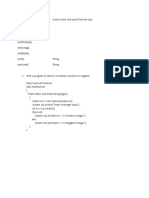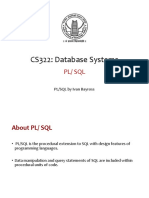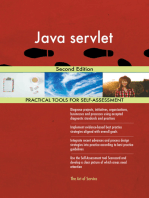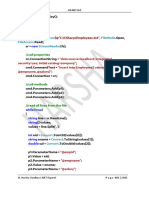0 ratings0% found this document useful (0 votes)
191 viewsSQL PL SQL Content
This document provides an overview of the topics that will be covered in an Oracle SQL and PL/SQL training course. The training will cover 16 chapters on topics such as database design, Oracle installation, SQL commands, constraints and keys, queries and joins, views and sequences, subqueries, performance tuning, PL/SQL control structures, procedures, functions, triggers, exceptions and more. The training aims to provide practical, real-time learning and also includes resume and placement support.
Uploaded by
NiranjanCopyright
© © All Rights Reserved
We take content rights seriously. If you suspect this is your content, claim it here.
Available Formats
Download as PDF, TXT or read online on Scribd
0 ratings0% found this document useful (0 votes)
191 viewsSQL PL SQL Content
This document provides an overview of the topics that will be covered in an Oracle SQL and PL/SQL training course. The training will cover 16 chapters on topics such as database design, Oracle installation, SQL commands, constraints and keys, queries and joins, views and sequences, subqueries, performance tuning, PL/SQL control structures, procedures, functions, triggers, exceptions and more. The training aims to provide practical, real-time learning and also includes resume and placement support.
Uploaded by
NiranjanCopyright
© © All Rights Reserved
We take content rights seriously. If you suspect this is your content, claim it here.
Available Formats
Download as PDF, TXT or read online on Scribd
You are on page 1/ 4
Oracle SQL & PL-SQL Training
All Trainings Are Completely Practical, Real-Time. Resume, Placement Support Included
For Free Demo Call Us [24 x 7] @ 9666 44 0801, 9666 64 0801
CHAPTER 1 : INTRODUCTION TO DBMS
What is Data and Information?; Purpose of Data Management; File and File System For Data Storage;
Disadvantages of File Data Management; Database : Purpose, Basic Terminology; Advantages of
Database for Data Storage; Possible Operations on the Database; Database Models – Hierarchical
Model; Network Model and Relational Model; Introduction to DBMS; Introduction to RDBMS;
Database Design; Most Popular RDBMS Products; History, Real-time Database Examples (LIVE)
CHAPTER 2: ORACLE INSTALLATION
Oracle 2018 Installation Guidance; Oracle 2012 Installation ; Installation Pre-Requisites and
Precautions; Oracle Sql Developer; Oracle Sql Command prompt; Oracle Versions and Editions
Comparisions ; Connect Sql Developer Tool; Creating a new User ; Grant permission; Lock and Unlock
User Account; How to Reset User Account Password; SQL* Plus; How to Establish the Oracle
Connection; Default System user in Oracle; Default Sysdba user in Oracle
CHAPTER 3: INTRODUCTION TO RDBMS
Features of RDBMS; Advantages of RDBMS; E.F Codd Rules for RDBMS; Normalization Concepts &
Process; Client Server Communication; Oracle Corporation Products; RDBMS from Other Vendors:
Microsoft, IBM, etc; Oracle Versions about SQL & SQL*PLUS; Database Types: OLTP and OLAP
Databases; Real-world Advantage of OLTP & OLAP; Why a database is called as Relational Database
SQL School , 101, 1st Floor, UMA Residency, B/S Metro Stn., SR Nagar, Hyderabad. Microsoft Learning Partner.
For Free Demo, call on 9666 44 0801 OR 9666 64 0801 (24 x 7) www.sqlschool.com
Model; Database Entites and Attributes; Applicative use of RDBMS Databases
CHAPTER 4 : SQL LANGUAGE COMMANDS
Structured Query Language (SQL) Basics; What is SQL?; What Can SQL do?; Possible Operations with
SQL; Data Definition Language (DDL); Data Retrieval Language (DRL); Data Manipulation Language
(DML); Transaction Control Language (TCL); Database Security and Privileges (DCL); Rules of SQL
Queries and Statements; Real-world applicative uses of SQL; Creating Users and Tables; Table Data
Inserts and Validations; Oracle Data Types; DDL Commands with Examples; CREATE, ALTER,
TRUNCATE,DROP,RENAME; Learn the DESCRIBE command to display the table structure; DML
Command DRL Commands Operators; INSERT, UPDATE, DELETE Statements; Difference between
Truncate and Delete commands; SELECT Statements with Multiplier; SQL Comments; Single Line
Comments & Multi Line Comments; WHERE Keyword for Query Conditions
CHAPTER 5 : SQL SPECIAL OPERATORS
SET, AND, OR, NOT, IN; Special Operators – IN (NOT IN); BETWEEN (NOT BETWEEN); Arithmetic and
Logical Operators; Understand Operator Precedence; UNION, UNION ALL, INTERSECT, MINUS; LIKE
(NOT LIKE), IS NULL (IS NOT NULL); Understanding DCL and TCL Commands; Transaction Concepts in
Databases with SQL; Transaction Types and Uses; Commit and Rollback Operations; Nested
Transactions with Savepoints; Database Read Consistency with SQL; DDL and DML Operations with
Transactions
CHAPTER 6: GROUPING QUERY RESULTS
Identify Distinct Values in Tables; Group Function or Aggregate function ; Group By Syntax; Group By
Operations in Queries; Having Clause of DRL Statements; Aggregate Functions with Group By; Order By
Clause and Group By; SQL Group By Statement; Query Execution Order with Group By; Arithmetic
Functions, Character Function; Date & Time Functions, String Function; Conversion Functions,
Analytical Function; Rank(), Dense_Rank(),Row_Number(); NVL(),NVL2(), NullIF(),Coalesce();
CHAPTER 7 : CONSTRAINTS & KEYS
Importance of Data Integrity; Working with Integrity constraints; Types of Integrity Constraints;
Domain Integrity Constraint and Usage; Entity Integrity Constraints and Usage; Referential Integrity
Constraint and Usage; Check Constraints and Usage; NOT NULL Constraint, UNIQUE Constraint;
PRIMARY KEY Constraint and Usage; FOREIGN KEY Constraints and Relations; Column Level & Table
Level Constraints; Adding Constraints to Tables, User Constraints ; Enabling - Dropping Constraints;
Disabling Constraints on Tables; Querying for Constraints Information, Self Referential Key
CHAPTER 8 : QUERIES & JOINS
Need for Joins and Table Comparisons; SET Operations on Tables and Joins; Join Types : Equi Join,
Simple Join; Inner Join and Query Conditions; Cross Join (Cartesian Join), Conditions; Join syntax - Sql
syntax and Ansi Syntax; Non-Equi Join and Self Join; Outer Joins – Types, Advantages and Usage; Cross
Joins – Advantages and Limitations; Self Joins, Merge Joins and Sub Queries; Using Aliases in Joins and
Conditions; Using Inner Self Joins with HAVING; JOINS and GROUP BY Queries
CHAPTER 9 : VIEWS, SYNONYMS,SEQUENCES
SQL School , 101, 1st Floor, UMA Residency, B/S Metro Stn., SR Nagar, Hyderabad. Microsoft Learning Partner.
For Free Demo, call on 9666 44 0801 OR 9666 64 0801 (24 x 7) www.sqlschool.com
VIEWS IN ORACLE, Understanding Views & Use; Relational Views and Standard Views; SIMPLE VIEWS
and COMPLEX VIEWS in PLSQL; Column Definitions in VIEWS; Using VIEWS for DML Operations; Forced
Views, CHECK Constraints in Views; Creation of READ ONLY VIEWS - Realtime Use; TOP-N Analysis,
(Indexed) Materialized Views; SequenWorking ces, with Synonyms; What is the Use of Synonym in
Oracle?; Difference between View and Synonym in Oracle; When should Table Synonyms be used?;
Public Synonym and Private Synonyms; All_Synonyms and Dba_Synonyms System Tables; Creating
Index Tables – Purpose
CHAPTER 10 : SUB QUERIES, NESTED QUERIES
Sub Queries in Real-world; Dynamic Conditions with Sub Queries; Sub Queries and Nested Sub
Queries; How does oracle Execute Nested Sub Queries?; Inner Select and Outer Select Queries; Usage
of Sub Queries with WHERE, HAVING; Impact of Having Clause in Sub Queries; Select Nth Highest
salary ; Select Duplicate Records; Delete Duplicate Records; Advantages of Oracle Sub Query; Subquery
in the Select Clause Examples; Subquery in the From Clause Examples; Display Odd Rows in a table;
Display Even Rows in a table; Execution of Correlated Sub Queries in SQL; IN, ANY SOME, ALL
Operators in Sub Queries; PAIR WISE and NON PAIR WISE in Sub Queries; Single Row Subquery &
Multiple Row Subquery; Multiple Column Subquery; UnCorrelated Subquery; Difference between
Correlated and Non-Correlated Subquery; How does Oracle Execute Correlated Subquery?; NULLs and
Correlated Sub Queries in SQL
CHAPTER 11: LOCKS in ORACLE TABLES
Open Transactions and Lock Concepts; Lock Types and Locking Mechanism; Row Level Locks for Table
Data Access; Table Level Locks and Query Blocking; Shared Lock and Real-time Use; Shared Update
Lock and Real-time Use; Exclusive Lock and Real-time Use; DeadLock : Detection, Prevention,
Avoidance; Implicit Locking Concepts in Oracle with PLSQL; How to check howmany locks are
occured?; LOCK Hints and Query Blocking; What is row exclusive lock in Oracle?; What is lock in SQL?;
What are different types of locks?
CHAPTER 12 : PERFORMANCE (QUERY) TUNING
Indexes - Definition and Architecture; B Tree Concept in Indexes; Clustered and Non clustered Indexes;
Primary Key and Clustered Index; Unique Key and Non Clustered Indexes; Simple Index, Rebuild Index;
Materialized Views - Indexed Views; Composite Index, Function Based Index; User_indexes System
Table; Range Partitions and Hash Partition; Partion “VALUES LESS THAN “ Clause; List Partition and
Composite Partition; Parallel Query Process with Partitions; Performance Tuning Advantages
CHAPTER 13 : PL/SQL – (CONTROL STRUCTURE) - Level I
Simple If, If..Else. Nested If..Else Statements; Ladder, Selection, Simple Case Statements; GOTO Label
and EXIT Statements in PL/SQL; Iterations in PL/SQL, Simple LOOP, WHILE; FOR LOOP and NESTED
LOOPS in PLSQL; PL/SQL Select statements; SQL within PL/SQL, Composite Data Types; Cursor
Variables and with Sub Queries, Reference Cursors; Implicit Cursors, Explicit Cursor; Parameterized
Cursors, Ref Cursors; REF Cursors Management in PL/SQL; Implicit & Explicit Cursors and Attributes;
Cursor with Parameters and Nested LOOPs; REF Cursors
CHAPTER 14: ADVANCED PL/SQL - 1
SQL School , 101, 1st Floor, UMA Residency, B/S Metro Stn., SR Nagar, Hyderabad. Microsoft Learning Partner.
For Free Demo, call on 9666 44 0801 OR 9666 64 0801 (24 x 7) www.sqlschool.com
Procedures in PL/SQL: STORED PROCEDURE; PROCEDURES @ Parameters (IN, OUT, IN OUT);
POSITIONAL Notation and NAMED Notation; Procedure with Cursors and Sub Queries; ALTER and
DROP of Stored Procedures; Functions in PL/SQL: Real-time Usage; User Defined Functions, Nested
Functions; Using Functions in SQL Statements; Working with Procedures and Functions; Comparing
Stored Procedures and Functions; Using SPs with Table Value Functions; Using SPs for Dynamic SQL
Statements; Loops and Table Variables in SQL Programs ; Merge, NVL2(), NULLIF(), COALESCE(); CASE &
Temporary /Global Tables
CHAPTER 15 : ADVANCED PL/SQL - 2
Cross Tab Views using Pivot/Unpivot Operators; Follows Clause and READONLY Tables; IN-LINE VIEWS.
Manipulations with Triggers; Purity Levels in Oracle - with Examples; User_Source Dictionary Table
Packages; Creating PACKAGE Specifications with PLSQL; PACKAGE Body - Examples with Big Data
Tables; Private and Public Objects in PACKAGE; Types of Exceptions: User Defined Exceptions;
EXCEPTIONS in PL/SQL with Real-time; Event Handling and Error Handling Techniques; Important Error
Code Values in PL/SQL; RAISE_APPLICATION_ERROR Procedure
CHAPTER 16 : ADVANCED PL/SQL - 3
Pragma_Autonomous_Transaction() with SPs; Returning into clause, Bulk Collect; For All,
Definer/Invoker Rights & Usage; About Flash Back Queries, Dynamic SQL; Flash Back Command, Purge
Command; Regular Expressions in PLSQL; What is the Recycle Bin?; How to Delete RecycleBin Table?;
How to Delete Recycle Bin?; SQL Loader - Flat file into Oracle table; Abstract Datatypes; DML Error
Logging and Virtual Columns; Types of Triggers, Row Level Triggers; Statement Level Triggers, DML
Triggers; DDL Triggers and Schema Level Triggers; Using OLD & NEW References, Trigger Auditing;
Enabling / Disabling Triggers, Dropping Triggers; Triggers in PL/SQL and Data Manipulations; Using
Memory Tables in Triggers; DML and DDL Events with Triggers; Compound Triggers, New data types;
Working with LARGE Tables in PLSQL; New: EXTRACT(), Autonomous Transaction; Pragma
Exception_init in oracle
CHAPTER 17: IMPLEMENTING OBJECT TECHNOLOGY – Level I
Object Technology and Applicative Use; OOPS-Object Instances, Creation of Objects; Creating User
Defined Data Types; Creating Object Tables in Oracle; Inserting rows in Table using Object; Retrieving
data from Object Based Tables; Calling a Method, Indexing Abstract; Data type Attributes in PLSQL;
Advantages of Collections; Ref Cursor (Dynamic Cursor), Weak Ref Cursor; Strong Ref Cursors and
Nested Tables; Associative Arrays, VARRAYS/VARYING arrays; Creating tables using Nested Tables;
Inserting, Updating & Deleting; Nested, Table Records
CHAPTER 18: IMPLEMENTING OBJECT TECHNOLOGY – Level II
Perform a Basic Search using the REGEXP_LIKE function; patterns using the REGEXP_INSTR function;
Extract Substrings using the REGEXP_SUBSTR function; Replace Patterns Using the REGEXP_REPLACE ;
Invisible Columns in Oracle Database 12c ; What is fetch in SQL?; Can we use limit in Oracle?; What is
offset in Oracle?; Is PL SQL object oriented?; What is Oracle object type?; What is object type in Oracle
PL SQL?; Is Oracle object oriented database?; What is PL SQL in Oracle?; What is Oracle constructor?
SQL School , 101, 1st Floor, UMA Residency, B/S Metro Stn., SR Nagar, Hyderabad. Microsoft Learning Partner.
For Free Demo, call on 9666 44 0801 OR 9666 64 0801 (24 x 7) www.sqlschool.com
You might also like
- Java 17 Backend Development: Design backend systems using Spring Boot, Docker, Kafka, Eureka, Redis, and TomcatFrom EverandJava 17 Backend Development: Design backend systems using Spring Boot, Docker, Kafka, Eureka, Redis, and TomcatNo ratings yet
- Apache Cassandra Administrator Associate - Exam Practice TestsFrom EverandApache Cassandra Administrator Associate - Exam Practice TestsNo ratings yet
- Oracle 12C - (SQL & PL/SQL) : 1.fundamentals of DatabaseNo ratings yetOracle 12C - (SQL & PL/SQL) : 1.fundamentals of Database8 pages
- Oracle SQL and PLSQL Training Course SyllabusNo ratings yetOracle SQL and PLSQL Training Course Syllabus5 pages
- Oracle Database Mastery: Comprehensive Techniques for Advanced ApplicationFrom EverandOracle Database Mastery: Comprehensive Techniques for Advanced ApplicationNo ratings yet
- RDBMS Concepts: © Tata Consultancy Services Ltd. July 7, 2018 1No ratings yetRDBMS Concepts: © Tata Consultancy Services Ltd. July 7, 2018 138 pages
- NareshIT SQLServer Training Notes02 BangarRajuNo ratings yetNareshIT SQLServer Training Notes02 BangarRaju84 pages
- Introduction To RDBMS Participant GuideNo ratings yetIntroduction To RDBMS Participant Guide182 pages
- Data Minds - Data Science Curriculum 2023 V2No ratings yetData Minds - Data Science Curriculum 2023 V215 pages
- DBMS - JS in Database Management Systems With Its Operations and Its FunctionalitiesNo ratings yetDBMS - JS in Database Management Systems With Its Operations and Its Functionalities71 pages
- Madhu - Software - Sparks - SQL - PLSQL GuideNo ratings yetMadhu - Software - Sparks - SQL - PLSQL Guide215 pages
- By Ram Reddy by Ram Reddy: #209, Nilagiri Block, Adithya Enclave, Ameerpet, HYD @8801408841, 8790998182No ratings yetBy Ram Reddy by Ram Reddy: #209, Nilagiri Block, Adithya Enclave, Ameerpet, HYD @8801408841, 8790998182255 pages
- IBM InfoSphere Replication Server and Data Event PublisherFrom EverandIBM InfoSphere Replication Server and Data Event PublisherNo ratings yet
- The Complete Spring Boot: A Comprehensive Guide to Modern Java ApplicationsFrom EverandThe Complete Spring Boot: A Comprehensive Guide to Modern Java ApplicationsNo ratings yet
- List Vs Mutability:: Once We Creates A List Object, We Can Modify Its Content. Hence List Objects Are Mutable. EgNo ratings yetList Vs Mutability:: Once We Creates A List Object, We Can Modify Its Content. Hence List Objects Are Mutable. Eg100 pages
- GS 191 Course Pack -Revised Edition, 2020No ratings yetGS 191 Course Pack -Revised Edition, 2020104 pages
- Autodesk Nastran 2022 Linux Installation Manual 17No ratings yetAutodesk Nastran 2022 Linux Installation Manual 171 page
- An Overview of Blockchain in Supply Chain Management: Benefits and IssuesNo ratings yetAn Overview of Blockchain in Supply Chain Management: Benefits and Issues11 pages
- Updated Orientation Deck - Google - Final - V2No ratings yetUpdated Orientation Deck - Google - Final - V215 pages
- OpenShift - Container - Platform 4.3 Authentication en USNo ratings yetOpenShift - Container - Platform 4.3 Authentication en US141 pages
- Connectivity Frameworks For Smart Devices The Internet of Things From A Distributed Computing Perspective 1st Edition Zaigham Mahmood (Eds.)100% (7)Connectivity Frameworks For Smart Devices The Internet of Things From A Distributed Computing Perspective 1st Edition Zaigham Mahmood (Eds.)62 pages













































































































